
Star Trek: The Next Generation – A Final Unity is an adventure game by Spectrum HoloByte, based on the Star Trek universe. It was released in 1995 for the DOS and later ported to the Macintosh. It puts the player in control of Captain Picard and his crew of the Enterprise D and features traditional point-and-click adventure gameplay as well as free-form space exploration, diplomatic encounters and tactical ship-to-ship combat.

Star Trek: Armada is a real-time strategy video game for Microsoft Windows developed and published in 2000 by Activision. The game's look and feel is based primarily on Star Trek: The Next Generation, and features a few of its main characters and ships. Playable factions include the United Federation of Planets, the Klingon Empire, the Romulan Star Empire and the Borg. The game received mixed to positive reviews and was noted for being one of the better Star Trek games to be made. A sequel, Star Trek: Armada II, was released on November 16, 2001.

Star Trek Generations is a 1997 first-person shooter with adventure and strategy elements by MicroProse, based on Star Trek Generations (1994), the seventh film in the Star Trek film franchise. It includes voice-acting by much of the cast of the film including actors Patrick Stewart, William Shatner, and Malcolm McDowell, as well as footage from the film.
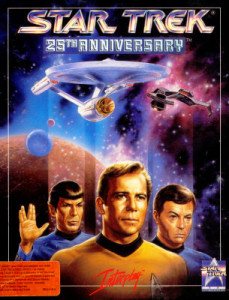
Star Trek: 25th Anniversary is an adventure video game developed and published by Interplay Productions in 1992, based on the Star Trek universe. The game chronicles various missions of James T. Kirk and his crew of the USS Enterprise. Its 1993 sequel, Star Trek: Judgment Rites, continues and concludes this two-game series.

The Gorn are a fictional extraterrestrial humanoid reptilian species in the American science fiction franchise Star Trek. They first appeared in a 1967 episode of the original series, "Arena", in which Captain Kirk fights an unnamed Gorn on a rocky planet. The fight scene has become one of the best-remembered scenes of the original series, in part due to the slow and lumbering movement of the Gorn, which some viewers have considered unintentionally comical.

Enterprise (NX-01) is the fictional spaceship that serves as the primary setting of the American science fiction television series Star Trek: Enterprise. The ship predates the other Starfleet ships named Enterprise and was first seen in the pilot episode "Broken Bow". Its missions included an initial period of deep space exploration and a mission into the Delphic Expanse following the Xindi attack on Earth; it was also instrumental in the formation of the United Federation of Planets with the Vulcans, Andorians and Tellarites.
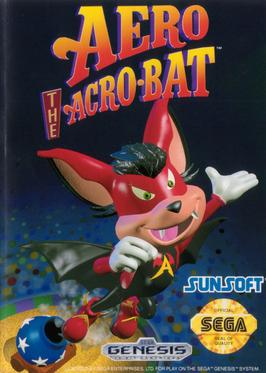
Aero the Acro-Bat is a 1993 video game developed by Iguana Entertainment and published by Sunsoft. It was released for both the Super Nintendo Entertainment System and Sega Genesis. Aero the Acro-Bat, a red anthropomorphic bat, was created by David Siller. In 2002, Metro 3D released a version of the game for the Game Boy Advance, with a battery back-up. The GBA version was titled Aero The Acro-Bat - Rascal Rival Revenge in Europe and Acrobat Kid in Japan. The Super NES version of the game was released on the Wii's Virtual Console in the PAL region on July 23 and in North America on July 26, 2010.
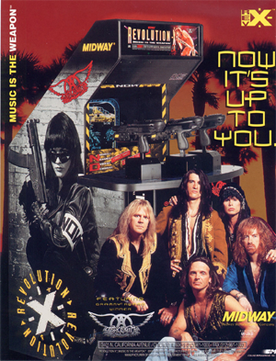
Revolution X is a shooting gallery video game developed by Midway and released in arcades in 1994. The gameplay is similar to Midway's earlier Terminator 2: Judgment Day, but is themed around the band Aerosmith. The oppressive New Order Nation regime and their leader Helga have abducted Aerosmith, and players use a mounted gun to control onscreen crosshairs and shoot enemies. The members of Aerosmith are hidden throughout the game's international locales and must be found in order to receive the game's true ending.
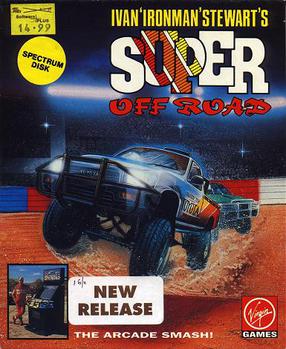
Ivan "Ironman" Stewart's Super Off Road is an arcade video game released in 1989 by Leland Corporation. The game was designed and managed by John Morgan who was also lead programmer, and endorsed by professional off-road racer Ivan Stewart. Virgin Games produced several home versions in 1990. In 1991, a home console version for the Nintendo Entertainment System was later released by Leland's Tradewest subsidiary, followed by versions for most major home formats including the Master System, Genesis, Super NES, Amiga, and MS-DOS. A port for the Atari Jaguar was announced but never released. Some of the ports removed Ivan Stewart's name from the title due to licensing issues and are known simply as Super Off Road.

Star Trek: The Role Playing Game is a role-playing game set in the fictional Star Trek universe published by FASA Corporation from 1982 to 1989.
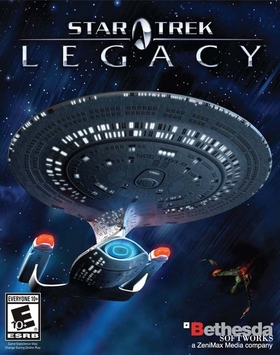
Star Trek: Legacy is a 2006 real-time tactics space combat video game for Microsoft Windows and Xbox 360 developed by Mad Doc Software and published by Bethesda Softworks in association with CBS Paramount Television and CBS Consumer Products. Originally slated for release in the fall of 2006 to coincide with the 40th anniversary of Star Trek, the Windows version was not released in North America until December 5, 2006, and the Xbox 360 version until December 15. In Europe, both the PC version and the Xbox 360 version were released on December 22, 2006.

Troy Aikman NFL Football is an american football video game originally developed by Leland Interactive Media and published by Tradewest for the Super Nintendo Entertainment System first in North America on August 1994. Officially licensed from the National Football League, it prominently features former NFL player Troy Aikman, who became the first member of the 1993 Dallas Cowboys to have his namesake in a game, followed by his teammate Emmitt Smith in Emmitt Smith Football.

Star Trek: Starfleet Academy is a Star Trek PC simulation game developed and published by Interplay in 1997. The game simulates the life of a typical Starfleet cadet, with the player learning the basics of flying a starship and engaging in roleplaying with a crew of cadets, with the eventual goal of becoming captain of their own ship. The game included full motion video featuring William Shatner, Walter Koenig, and George Takei reprising their roles from the original television series and movies, and a multiplayer simulation mode allowing for up to 32 players.
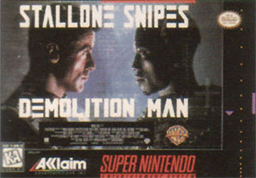
Demolition Man is a pair of action video games based on the film of the same name. Acclaim Entertainment published the 16-bit version, which features run and gun gameplay, for the Super NES, Sega Genesis and Sega CD. Virgin Interactive released a completely different game for the 3DO that combined several distinct gameplay styles. In both games, the player controls John Spartan, the main character from the film, as he attempts to find and defeat his nemesis, Simon Phoenix.

Star Trek: Encounters is a video game set in the Star Trek fictional universe, which was released in 2006 for the PlayStation 2. The game was developed by Scottish studio 4J Studios for Bethesda Softworks and Ubisoft (EU).

Dragon: The Bruce Lee Story is a fighting video game developed and originally published by Virgin Interactive Entertainment in Europe for the Sega Genesis in June 1994. It is based on the 1993 film of the same name, which is a semi-fictionalized account of the life of Hong Kong-American actor and martial artist Bruce Lee. Following the events of the movie, players take control of Bruce Lee across several stages that takes places in different time periods of his life and fight against some of his adversaries.
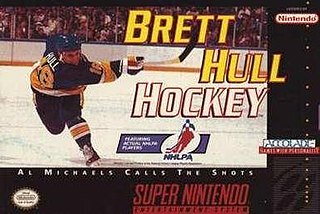
Brett Hull Hockey is an ice hockey video game developed by Radical Entertainment and originally published by Accolade for the Super Nintendo Entertainment System in North America in January 1994. It prominently features former Canadian-American NHL player Brett Hull and is officially licensed from the NHL Players' Association.

Creature Shock is a 1994 sci-fi game released for MS-DOS and 3DO. It was developed by Argonaut Software and published by Virgin Interactive Entertainment. The game was later ported to the CD-i, Sega Saturn and PlayStation video game systems.
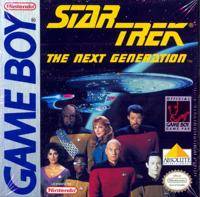
Star Trek: The Next Generation is a large spaceship simulation video game based on the Star Trek follow-up series of the same name. It was released in 1993 to the North American and European markets for both the Nintendo Entertainment System (NES) and Game Boy.

Star Trek: The Rebel Universe is an action-adventure computer game published by Firebird Software in Europe and Simon & Schuster Interactive in America. It was originally released for the Atari ST in 1987, and was followed the next year with versions for the Commodore 64 and DOS.





















